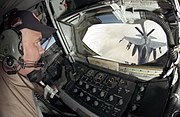Computer control of in-flight refuelling
 The tanker aircraft being built for the RAAF (Airbus A330 MRTT) have a fly-by-wire, refuelling boom (the CASA Advanced Refuelling Boom System (ARBS). This is controlled by an operator on the tanker aircraft flight deck looking at a synthetic 3-D image on a screen (the Remote Aerial Refuelling Station) and "flying" the boom with a joystick. As the boom is electrically operated with a computer relaying the operator's instructions, there is the potentially to further automate the system to make refuelling faster and lower the workload on the operator.
The tanker aircraft being built for the RAAF (Airbus A330 MRTT) have a fly-by-wire, refuelling boom (the CASA Advanced Refuelling Boom System (ARBS). This is controlled by an operator on the tanker aircraft flight deck looking at a synthetic 3-D image on a screen (the Remote Aerial Refuelling Station) and "flying" the boom with a joystick. As the boom is electrically operated with a computer relaying the operator's instructions, there is the potentially to further automate the system to make refuelling faster and lower the workload on the operator.The Airbus system differs from that previously developed by the US Air Force, where an operator sits in the rear of the tanker aircraft and controls the boom while looking out of a window. However, even with the Airbus computer interface this is a complex process. The receiving aircraft has to be guided in using instructions via radio or lights on the tanker (similar to traffic lights). When in the contact position the receiving aircraft has to hold its position while the boom is locked in place and fuel is pumped. Much of this complex process could be automated to relieve the workload on the boom operator and speed the process:
Airbus operator's station
The AAR operator's station is equipped with a fuel control panel, with fuel pump controls and fuel quantity indicators, and a dual pod control panel. The AAR operator is responsible for control of the aircraft's rendezvous beacons and tanker illumination lights during air-to-air refuelling. The optional external video monitoring system uses infrared floodlighting for day-and-night monitoring of refuelling operations. ...
From: A310 MRTT Multi-Role Tanker Transport, Europe, SPG Media Limited, 2008
Boeing operator's station
While in contact, pilot director indicators (two rows of lights on the bottom of the tanker's fuselage change in relation to the nozzle's up/down and fore/aft movement) aid the receiver pilot in remaining within the air refueling envelope. The air refueling envelope -- a roughly cube-shaped area within which the nozzle and receptacle must remain during contact -- is slightly different for each receiver. Its boundaries are based either on boom movement limitations, or to prevent the receiver from moving into a position where any portion of the boom might touch the receiver outside the receptacle while in contact. The boom's mechanical limits stem from the both the structural limitations of yoke and trunnion system mounting the boom to the tanker, and the maximum deflection of the flexible nozzle. Should receiver movement left, right, up or down exceed the nozzle's deflection limits the nozzle could become mechanically bound in the receptacle (like trying to remove a key from a lock while pulling sideways instead of pulling straight back) preventing nozzle/receptacle disengagement. The boomer follows the receiver aircraft's movement with the ruddevator control stick to maintain alignment between the inner fuel tube and the outer structural portion of the boom. He or she also monitors the receiver's position, via three boom position indicators, and commands the toggles in the receptacle to disengage the nozzle -- a disconnect -- before the receiver aircraft exceeds any published air refueling envelope limit. ...
From: Aerial refueling, Wikipedia, 2008
Labels: aircraft, Defence IT, defence technology



0 Comments:
Post a Comment
Links to this post:
Create a Link or bookmark with Digg, del.icio.us, Newsvine or News Feed
<< Home